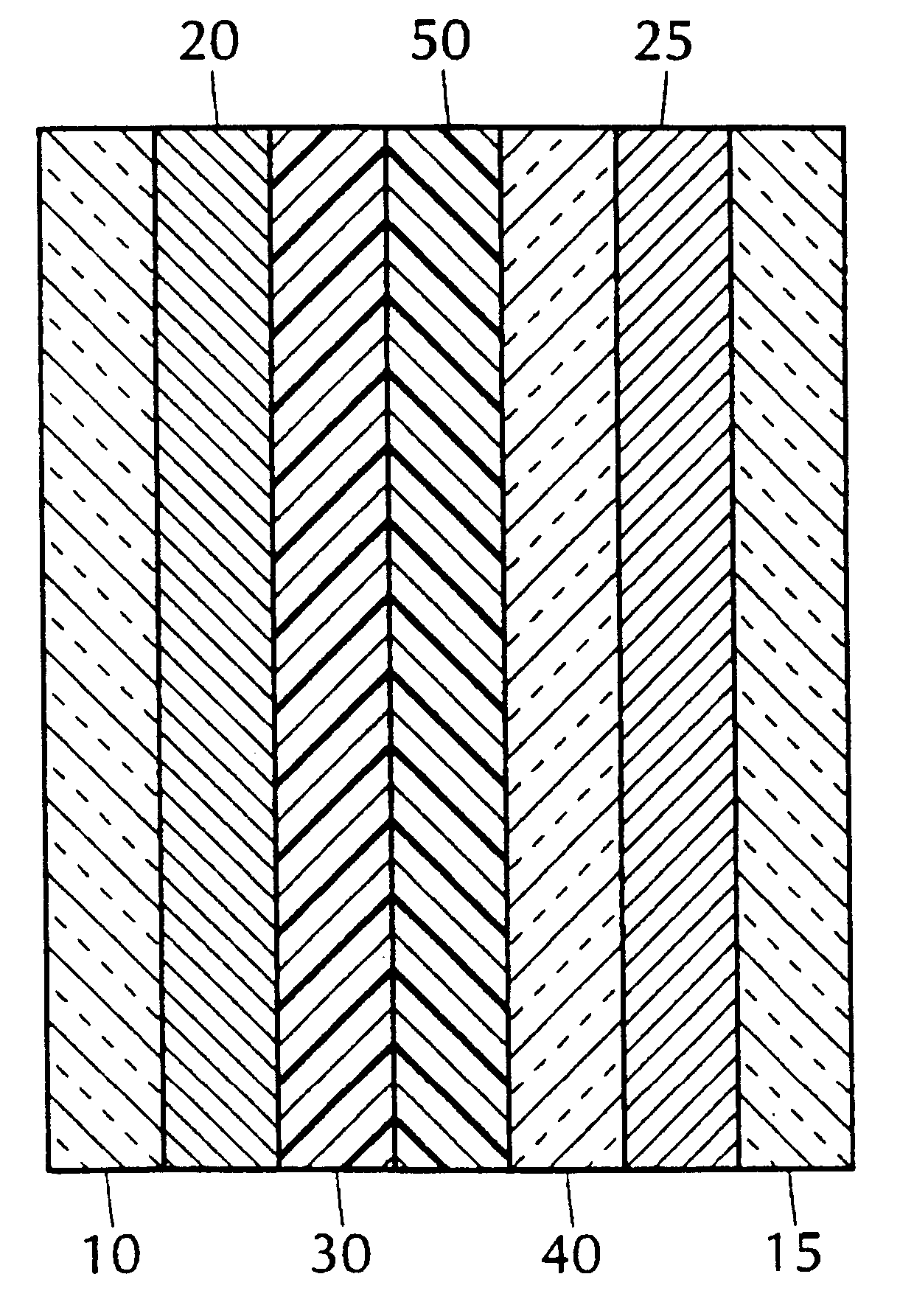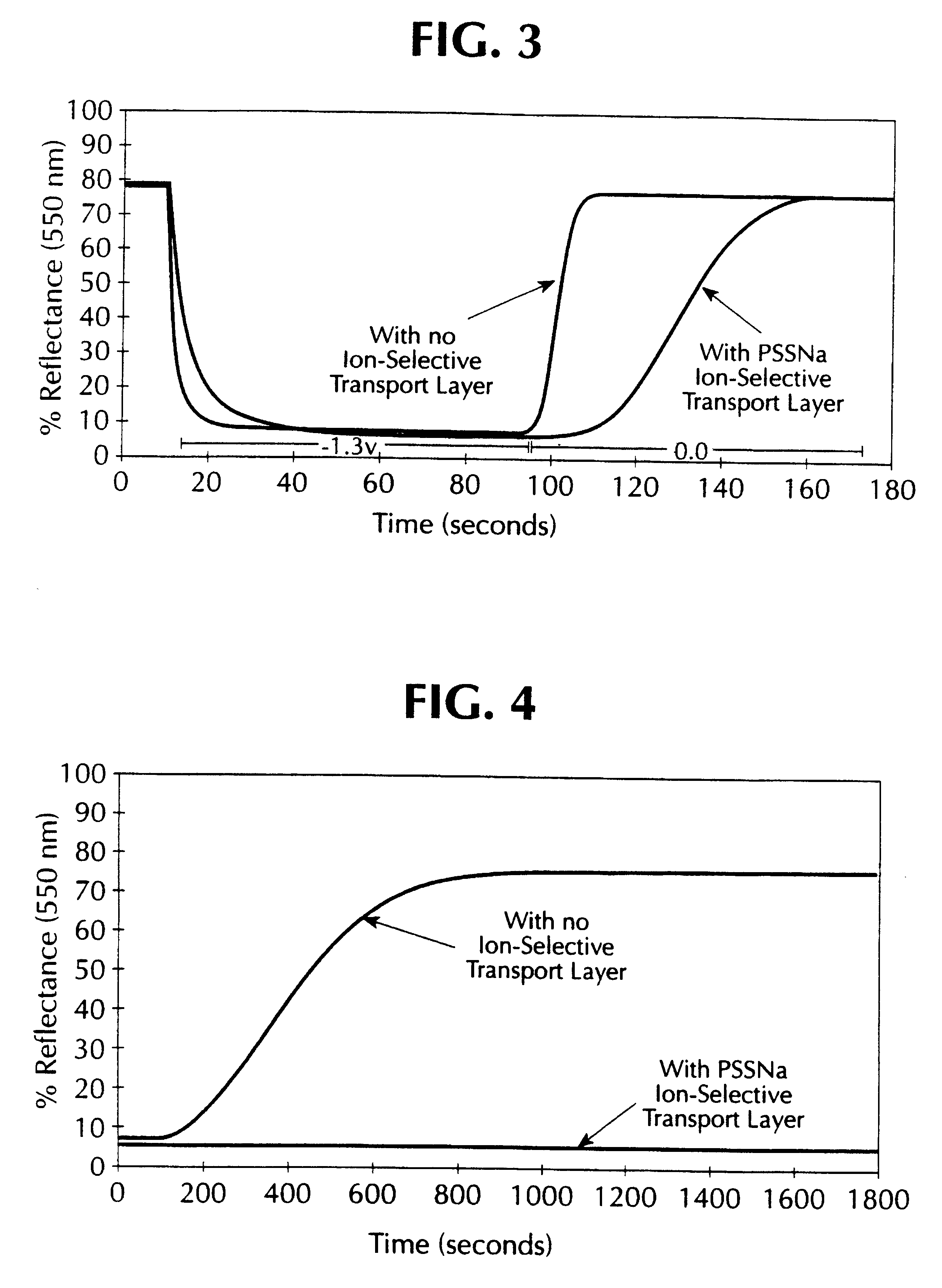Electrochromic devices
- Summary
- Abstract
- Description
- Claims
- Application Information
AI Technical Summary
Benefits of technology
Problems solved by technology
Method used
Image
Examples
example 1
Ta.sub.2 O.sub.5 Overcoated WO.sub.3 Electrode and Ferrocene Electrolyte
A similar device was made as described in comparative example 1, but the WO.sub.3 electrode was overcoated with a thin film of tantalum (V) oxide (Ta.sub.2 O.sub.5). The Ta.sub.2 O.sub.5 precursor solution was prepared by dissolving 1.3 milliliters of tantalum ethoxide in 30 milliliters of dry ethanol and 1.13 milliliters of 2,4-pentanedione as a complexing agent. This solution was stirred under an inert atmosphere for two hours. To this solution was added 0.06 milliliters of one normal (1N) hydrochloric acid and 0.034 milliliters of deionized water. This solution was stirred under nitrogen for two hours prior to use. The solution was then spin coated onto a transparent WO.sub.3 coated tin oxide glass substrate. The Ta.sub.2 O.sub.5 overcoat (selective ion transport layer) was cured at room temperature in an atmosphere of 50% relative humidity for 12 hours. The device was then assembled as described in comparati...
example 2
LiNbO.sub.3 overcoated WO.sub.3 Electrode and Ferrocene Electrolyte
A similar device was made as described in comparative example 1, but the WO.sub.3 electrode was overcoated with a thin film of LiNbO.sub.3. The LiNbO.sub.3 precursor solution was prepared by the addition of 0.8 milliliters of 2,4-pentanedione to dry ethanol followed by 3.0 milliliters of niobium ethoxide. This solution was stirred under dry nitrogen for approximately 3 hours. Then 1.2 grams of lithium 2,4-pentanedionate dissolved in 24 milliliters of dry methanol was added. The solution was stirred under nitrogen and filtered through a 0.5 micron Millipore filter. The solution was spin coated onto a transparent WO.sub.3 coated tin oxide glass substrate. The thickness of the LiNbO.sub.3 coating was between 500 to 600 angstroms. The coating was cured at room temperature. The device was then assembled as described in comparative example 1. The performance of the device was as follows:
When a potential of +1.3 V was appli...
example 3
SiO.sub.2 Thin Film Overcoated on WO.sub.3 Electrode and Ferrocene Electrolyte
A similar device was made as described in comparative example 1, except that the WO.sub.3 electrode was overcoated with a thin film of SiO.sub.2. The SiO.sub.2 overcoat was deposited by spin coating with a 1 volume percent solution of tetraethoxysilane in dry ethanol. The overcoated WO.sub.3 electrode was cured at room temperature prior to assembling into a cell as described in comparative example 1. The performance of the device was as follows:
When a potential of +1.3 V was applied to the device (the negative lead being connected to the WO.sub.3 coated electrode), its transmittance (measured at 550 nm) changed from 77% T to 11% T in about 90 seconds. The current in the colored state was 7.39 mA for an area of 45.5 cm.sup.2 (162 .mu.A / cm.sup.2). When the power source was disconnected, its transmission went back from 11% T to 41% T in about 120 seconds. When shorted in the colored mode the cell went from 11...
PUM
 Login to View More
Login to View More Abstract
Description
Claims
Application Information
 Login to View More
Login to View More - R&D
- Intellectual Property
- Life Sciences
- Materials
- Tech Scout
- Unparalleled Data Quality
- Higher Quality Content
- 60% Fewer Hallucinations
Browse by: Latest US Patents, China's latest patents, Technical Efficacy Thesaurus, Application Domain, Technology Topic, Popular Technical Reports.
© 2025 PatSnap. All rights reserved.Legal|Privacy policy|Modern Slavery Act Transparency Statement|Sitemap|About US| Contact US: help@patsnap.com



